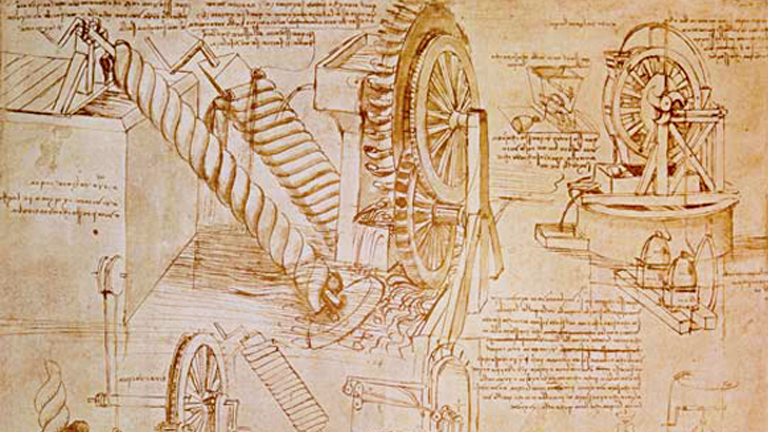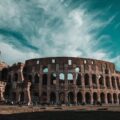His New Way to View the World
According to Leonardo’s observations, the study of mechanics, with which he became familiar as an architect and engineer, are also reflected in the workings of nature. His genius in synthesizing information and observation ultimately led to even broader concepts and a new school of thought based upon cognitive recognition. It was not just revolutionary, it was an entirely new way to view the world.
Throughout his life Leonardo was an inventive builder; he thoroughly understood the principles of mechanics of his time and contributed in many ways to advancing them. His notebooks dealt extensively with his theory of mechanics. Their importance is not only based on the description of specific uses for the machines and tools, but in the explanation of the principles and functions employed in building machinery. Only in rare cases was it was feasible for Leonardo’s designs to be constructed as demonstration models. As in his anatomical drawings, Leonardo developed definite principles of graphic representation – stylization, patterns and diagrams that provided precise illustration of the objects.
As was mentioned in Part II and III of this series, Leonardo was quite active as a military engineer, which began during his time in Milan. Although no definitive examples of his work can be identified, from his writings, we know that in 1504, Leonardo was sent by the Florentine governing council to study the city’s fortifications system as it was repaired and he suggested a detailed plan for overhauling it. His studies for large-scale canal projects in the Arno region and in Lombardy show that he one of the leading experts in his day in the area of hydraulic engineering.
Leonardo was especially intrigued by the problems of friction and resistance. Through his notebooks, we observe that for each of the mechanical elements he presented – such as screw threads, gears, hydraulic jacks, swiveling devices and transmission gears, his drawings that took precedence over the written word. Throughout his career he also was intrigued by the mechanical potential of motion. This led him to design a machine with a differential transmission, his moving fortress (resembling a modern tank/armored car) and of course, his flying machine. His helical airscrew (c. 1487), which researchers describe as the first conceptual example of a helicopter; however, like the other vehicles Leonardo designed, it presented a singular problem – it lacked an adequate source of power to provide propulsion and lift.
Wherever Leonardo probed the phenomena of nature, he recognized the existence of primal mechanical forces that govern the shape and function of the universe. This is seen in his studies of the flight of birds, in which his idea of the feasibility of a flying apparatus took shape and which led to exhaustive research into the element of air and its currents. Perhaps no one before him had ever so thoroughly contemplated the properties of a wisp of smoke. In Leonardo’s studies of water, the vetturale della natura (conveyor of nature), he was as much concerned with the physical properties of water as with its laws of motion and currents. He researched the natural laws that applied to the growth of plants and trees, as well as the geologic structure of earth, hill and mountain formation.
In his drawings, based on the numerous experiments he undertook, Leonardo found a stylized form of representation that was uniquely his own. This is especially evident in his studies of whirlpools. He broke down the phenomenon into parts – the ripples and rings surrounding the whirlpool, its eddies and funnel, while at the same time preserving the total picture, creating both an analytic study and visual diagram.
As the 15th century ended, Scholastic doctrines were in decline and humanistic scholarship was on the rise. Leonardo, however, was part of an intellectual circle that developed a third school – the modern form of cognition. In his view, the role of an artist was to convey the true and accurate experience acquired by visual observation. This played a significant role in his thought process. In an era that often compared divine creation to the activity of an artist, Leonardo reversed the analogy, using art as his own means to approximate the mysteries of creation. He asserted that through the science of painting, “the mind of the painter is transformed into a copy of the divine mind, since it operates freely in creating many kinds of animals, plants, fruits, landscapes, countrysides, ruins and awe-inspiring places.”
With this sense of the artist’s higher calling, Leonardo approached the vast realm of nature to probe its secrets. His idea of transmitting the knowledge he had acquired through art was at odds with medieval Scholastic conceptions; however, the results of Leonardo’s research and cognitive recognition were among the greatest achievements of the Renaissance. We now know that Leonardo’s legacy extends beyond his extraordinary talents of art, he truly developed a new way to think and a new way to view the world.





